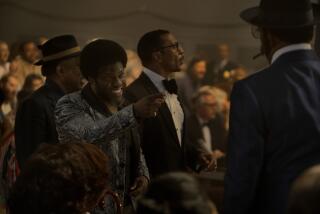Recalling the Thrill of the Chase
- Share via
The best chase movies, at their heart, are psychological duels. All the action, with throbbing pursuits and hall-of-mirrors escapes, are fine, but what we want are a cat and mouse with brains. The hunt explores character; it reveals what makes heroes and villains.
“The Fugitive” and “In the Line of Fire” fit the mold nicely. They represent, in many ways, meat-and-potatoes Hollywood: moving pictures that move fast through one near-miss and evasion after another.
But both also know that the most ingenuity should be reserved for the pursuer and the pursued. The train scene in “The Fugitive” may be a thrilling film gesture, but what I most remember is the desperate smarts of Harrison Ford’s Richard Kimble and the persuasive individuality of Tommy Lee Jones’ Sam Gerard.
Just about everybody knows that the new release is based on the TV series starring David Janssen as the forever worried-looking Dr. Kimble. But the original show was, at least in part, said to have been inspired by Victor Hugo’s classic novel, “Les Miserables.”
The book also inspired a handful of film versions, as well as a money-making Broadway musical. The most interesting of the movies came out in 1935, starring Frederic March as Valjean and Charles Laughton as Javert, the inspector who won’t let him rest. It’s a dark, melodramatic telling but with a disturbingly ambiguous performance by Laughton. His Javert is a complicated victim of obsession, duty and moral uncertainty.
Robert Redford, an actor not usually associated with subtlety, finds the strength and complexity of the man within in “Three Days of the Condor,” the underrated 1975 picture that provided him with one of his more demanding roles. As an ordinary guy who suddenly finds himself a CIA target, Redford brings a low-key resourcefulness to this conspiracy caper; Faye Dunaway shows up to give him a respite of romance on his winding way.
A more familiar Redford vehicle is “Butch Cassidy and the Sundance Kid.” The 1969 movie made him a glamour-boy powered by box office appeal. Despite all the counter-culture layering it has endured over the years, this is really just a basic Hollywood entertainment--but an irrepressible one. Redford and Paul Newman are an attractive outlaw couple, and their pursuit takes them through some beautiful American vistas, lovingly photographed.
A more provocative Western with a chase of its own is John Ford’s masterpiece, “The Searchers.” John Wayne and the plateaus, valleys and mountains Ford captured with such reverence are the stars in this story of a bitter man searching for his niece (Natalie Wood) captured by Indians several years earlier. The underlying theme of racism, not often looked at in a ‘50s Western (the film was released in 1956), adds to the film’s power.
Bigotry is tackled squarely, often heavily, in “The Defiant Ones,” one of Stanley Kramer’s message films of the ‘50s and ‘60s. There’s plenty of hyperventilated acting in the 1958 story about two escaped convicts (Sidney Poitier and Tony Curtis) forced to deal with their prejudices while chained together on the run, but it’s also intense and urgently paced.
The chase isn’t always man against man. The ever-ambitious John Huston tried to bring Herman Melville’s “Moby Dick” to the screen in 1956. Not always successful (the film sacrifices the novel’s sweep and soggy grandeur), it nonetheless has several striking passages. Gregory Peck is game, despite the obvious miscasting; he infuses Captain Ahab with an insane malice that startles. His nemesis, the great white whale, is also vivid--a special effects behe moth that dominates every frame.
Hitchcock, of course, knew something about suspense and frequently turned to a prolonged pursuit to create it. “North by Northwest” finds Cary Grant in the role of a confused advertising executive on the run from both the cops and spies. Hitchcock’s trustworthy inventiveness with the camera and editing and his always droll wit have made this 1959 picture a classic.
Humor adds even more pep to the chase in Billy Wilder’s “Some Like It Hot.” Tony Curtis and Jack Lemmon play a couple of hard-luck musicians forced to hide out with an all-woman’s orchestra after witnessing the St. Valentine’s Day Massacre. Watching the 1959 movie is like drinking something highly carbonated--everything about it, from Curtis and Lemmon’s romps in drag while avoiding mobsters to Marilyn Monroe’s breathless performance, tickles going down.
A few other suggestions:
“Bullitt” (1968), “The French Connection” (1971), “The Third Man” (1949), “The Blues Brothers” (1980), “Sugarland Express” (1974) and “Duel” (1971).
More to Read
Only good movies
Get the Indie Focus newsletter, Mark Olsen's weekly guide to the world of cinema.
You may occasionally receive promotional content from the Los Angeles Times.










